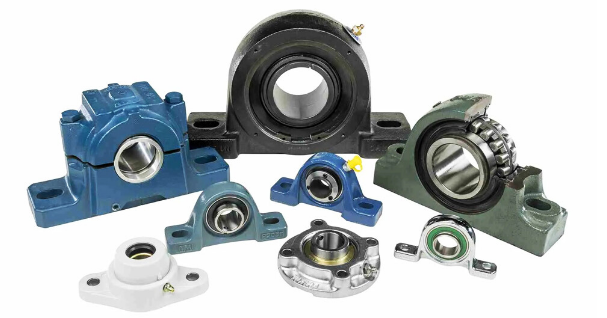A pillow block bearing unit is a kind of housed bearing with a machined mounting surface. They support shafts in mechanical transmissions. Pillow block bearing units are widely used in systems transmitting mechanical power to support shafts and couplings. They are integral components for many machines that ensure that shafts remain in place and run with ease. They fall under the category of housed-bearing units.
What is a Pillow Block Bearing?
Pillow block bearings support the rotating shafts. They consist of a pillow or plummer block serving as the bearing housing so that it can be fixed onto a surface. Pillow block bearings are important in many different sectors because they reduce friction and allow spinning machinery to work in a smooth and efficient way.
Functionality and Design
Typical units are an assembly of a bearing that is installed in a housing, giving the shaft a solid platform. Internal bearings can be ball bearings, cylindrical bearings, tapered rollers, or synthetic bushings depending on the application needs. The housing can be split or solid to provide easier installation and maintenance.
Plummer Block vs. Pillow Block
With a slightly different construction, they are sometimes called “Pummel blocks.” A very important distinction must be made between pillow block and plummer block bearing units. Pillow blocks are designed to work best in light to medium weight circumstances, while plummer blocks are designed to operate under heavier loads and in industrial environments, even though their functions are similar. Depending on the application, there are a number of bearing types and construction materials that can be utilized.
Pillow Block Bearing Types
Pillow block bearings can be classified on the basis of the type of bearing used and the housing construction. These are typically one-piece housings used on applications where replacement of bearings is less frequent. Provide greater stiffness. Split-housed bearings are designed as two-piece housings that allow for easier replacement in applications where access to maintenance is crucial.
Bearing Types
Plain bearings are a category of bearings that are applicable for operations involving lower loads and speeds. The ball bearings find extensive applications because of their versatility and are designed to bear axial and radial stresses.
- Roller Bearings: Tapered roller bearings are best suited for applications with strong radial and axial loads.
- Spherical Roller Bearings: Used in heavy-duty applications and support misalignment of shafts.
- Cylindrical roller bearings: These are applied where high-speed applications with large radial loads have to be supported.
Housing Materials for Pillow Block Bearings
Housing material is critical for pillow block bearings to be durable and to function suitably in different conditions.
- Cast Iron: One of the most popularly used metals because it has a reasonable price and toughness. Used for a broad range of purposes.
- Stainless Steel: Extremely resistant to erosion, and best for uses in large-humidity and food.
- Thermoplastic: Used where light, noncorrosive materials are required; in general, it provides good chemical resistance.
How to Choose Pillow Block Bearings
Various considerations when one is choosing a pillow block bearing include:
- Load Types and Bearing Types: Ball-bearing, plain bearing, Roller bearings include spherical, cylindrical, and tapered roller bearings while load type includes axial or radial.
- Shaft Attachment: Units can have a tapered adapter, concentric lock, eccentric lock, single or double set collars, or a set screw.
- Seals: There are different types of seals such as auxiliary-type, light contact, heavy contact, and clearance seals.
- Shaft Size: The diameter of the bearing should be the same as that of the shaft.
- Running speed: Higher speeds necessitate the use of special bearing types.
- Misalignment: If there is an expectation of shaft misalignment, then select bearings that can accept such misalignment.
- Environment and Mounting Style: Split or solid housings and Temperature, contamination or humidity etc.
Important Considerations for Pillow Block Bearing Sizing
The accuracy of the pillow block bearing is a function of a number of parameters that include:
Load Type and Capacity
The radial load is perpendicular to the shaft. It finds application in conveyor belts, amongst others. A load parallel to the shaft is called an axial load. It may be encountered in applications that involve a push or pull along the length of the shaft. A load that consists of a combination of both axial and radial is termed a combined load. Most common in practice. Note that loads exceeding the rated load capability of the bearing can cause it to fail prematurely.
Diameter of the Shaft
The bearing bore must be of the same dimensions as the shaft diameter. While one can place orders for shafts of any size, all shafts have standard sizes. Correct fitting of the shaft in the bearing allows smooth operation and prevents slipping.
Speed Rating
The application speed of the bearing should not exceed the rated limit of operational speed. In applications involving very high speeds, special bearing types may be necessary that can support higher rotational speed without overheating or undue wear.
Tolerance for Misalignment
The increased wear and friction caused by misalignment can eventually cause failure: pillow block bearings with spherical bearings can support some misalignment.
Conclusion
Because they facilitate the effective transfer of rotary motion, pillow block bearings are an essential part of industrial machinery. Pillow block bearing is vital to industrial efficiency in a variety of industries due to their extensive use in vital machinery. The advantages of lower operating costs, equipment dependability, and operational efficiency are still being offered by their continuous improvement.















